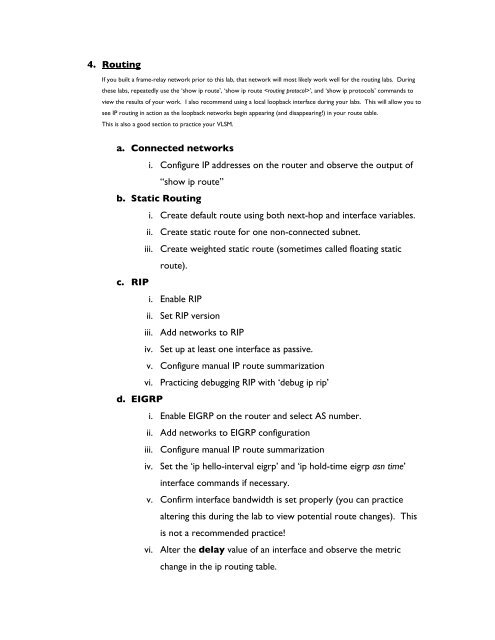CCNA Lab Recommendations.pdf - The Cisco Learning Network
CCNA Lab Recommendations.pdf - The Cisco Learning Network
CCNA Lab Recommendations.pdf - The Cisco Learning Network
You also want an ePaper? Increase the reach of your titles
YUMPU automatically turns print PDFs into web optimized ePapers that Google loves.
4. Routing<br />
If you built a frame-relay network prior to this lab, that network will most likely work well for the routing labs. During<br />
these labs, repeatedly use the ‘show ip route’, ‘show ip route ’, and ‘show ip protocols’ commands to<br />
view the results of your work. I also recommend using a local loopback interface during your labs. This will allow you to<br />
see IP routing in action as the loopback networks begin appearing (and disappearing!) in your route table.<br />
This is also a good section to practice your VLSM.<br />
a. Connected networks<br />
i. Configure IP addresses on the router and observe the output of<br />
“show ip route”<br />
b. Static Routing<br />
c. RIP<br />
d. EIGRP<br />
i. Create default route using both next-hop and interface variables.<br />
ii. Create static route for one non-connected subnet.<br />
iii. Create weighted static route (sometimes called floating static<br />
route).<br />
i. Enable RIP<br />
ii. Set RIP version<br />
iii. Add networks to RIP<br />
iv. Set up at least one interface as passive.<br />
v. Configure manual IP route summarization<br />
vi. Practicing debugging RIP with ‘debug ip rip’<br />
i. Enable EIGRP on the router and select AS number.<br />
ii. Add networks to EIGRP configuration<br />
iii. Configure manual IP route summarization<br />
iv. Set the ‘ip hello-interval eigrp’ and ‘ip hold-time eigrp asn time’<br />
interface commands if necessary.<br />
v. Confirm interface bandwidth is set properly (you can practice<br />
altering this during the lab to view potential route changes). This<br />
is not a recommended practice!<br />
vi. Alter the delay value of an interface and observe the metric<br />
change in the ip routing table.

















